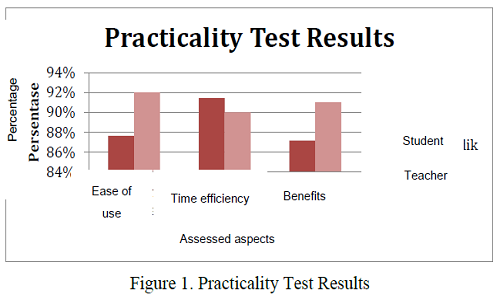
Development E-Assessment Using Kahoot! in Learning Chemistry of Electrolyte And Non-Electrolyte Solution Materials for SMA/MA
Abstract
This research aims to develop an e-assessment using Kahoot! Valid, reliable, also practical in learning the chemistry of electrolyte and non-electrolyte solution materials. The research subjects consisted of validators in their fields, subject teachers, and class XI students of SMA Negeri 13 Padang. This development research uses the Borg & Gall development model. The instrument in conducting this study used validation sheets and practicality questionnaires. The average result from the expert validation questionnaire was obtained at 0.91, meaning the product is valid and can be used. Analysis of question items received an average validity and reliability of questions of 0.50 and 0.88, respectively, indicating that the product is valid and reliable. The difficulty level is 20 "moderate" and 5 "easy" questions, the average differentiating power is 0.42 with good categories, and all deception works well. Based on the results of the practicality questionnaire, an average field trial of 89% of student responses and 91% of teacher responses was obtained, which means that the e-assessment tool uses Kahoot! Easy to use by teachers and learners.
Keywords
Full Text:
PDFReferences
Arikunto, Suharsimi. (2013). Dasar-dasar Evaluasi Pendidikan Edisi 2. Jakarta: Bumi Aksara.
Astalini, dkk. (2018). Identifikasi Sikap Implikasi Sosial dari IPA, Ktertarikan Menambah Waktu Belajar IPA, dan Ketertarikan Berkarir Dibidang IPA Siswa SMP Se-Kabupaten Muaro Jambi. Jurnal Ilmiah Kependidikan, 7(2), 93-108.
Dewi, Cahya Kurnia. (2018). Pengembangan Alat Evaluasi menggunakan Aplikasi Kahoot pada Pembelajaran Matematika Kelas X. Bandar Lampung: Universitas Negeri Raden Intan Lampung.
Gall, W. R. B., & D., M. (2007). Borg-and-Gall-Educational-Research-Research-and-Development.
Hamid, M. A. (2016). Pengembangan Instrumen Penilaian Hasil Belajar Siswa Berbasis TIK pada Pembelajaran Dasar Listrik Elektronika. Jurnal Ilmiah Pendidikan Teknik Elektro, 1(1), 37–46.
Heni, V., Sudarsono, S., & Regina, R. (2019). Using Kahoot To Increase Students' Engagement and Active Learning : a Game Based Technology To Senior High School Student. Proceedings International Conference on Teaching and Education (ICoTE), (2), 129–134.
Jeljeli, R., Alnaji, L., & Khazam, K. (2018). A Comparison Between Moodle, Facebook, and Paper-Based Tools: Student's Perception of Preference and Effect on Performance. International Journal of Emerging Technologies in Learning, 13(5), 86-98.
Jihad, Asep. (2012). Evaluasi Pembelajaran. Yogyakarta: Multi Pressindo.
Latisma. (2011). Evaluasi Pendidikan. Padang: UNP Press.
Lewis. R. Aiken. (1985). Three Coefficients for Analyzing the Reliability and Validity Of Ratings. Educational and Psychological Measurement, 4(5), 131–141.
Purnomo, A., Ratnawati, N., & Aristin, N. F. (2016). Pengembangan Pembelajaran Blended Learning Pada Generasi Z. In Jurnal Teori dan Praksis Pembelajaran IPS, 1(1), 70–76.
Purwanto. (2010). Evaluasi Hasil Belajar. Yogyakarta: Pustaka Pelajar.
Ridgway J, dkk. (2004). Literature review of e-assessment, NESTA Futurelab Series Report 10. Bristol: NESTA Futurelab.
Sudjono, A. (2011). Pengantar Evaluasi pendidikan. Jakarta: Rajawali.
Sudiyono, Anas. (2009). Pengantar Evaluasi Pendidikan. Jakarta: Rajawali Pers.
Sugiyono. (2013). Metode Penelitian Kuantitatif, Kualitatif, dan R&D. Bandung: CV. Alfabeta.
Yunus, Y., & Sardiwan, M. (2018). Perancangan dan Pembuatan Media Pembelajaran Berbasis Android pada Mata Pelajaran Sistem Komputer. Jurnal Pti (Pendidikan dan Teknonologi Informasi) Fakultas Keguruan Ilmu Pendidikan Universitas Putra Indonesia “Yptk” Padang, 31-41.
Zhang, Q., & Yu, Z. (2021). A literature review on the influence of Kahoot! On learning outcomes, interactions, and collaboration. Education and Information Technologies, 26(4), 4507-4535.
DOI: http://dx.doi.org/10.31258/jes.7.2.p.134-147
Refbacks
- There are currently no refbacks.
Copyright (c) 2023 Mela Devi Aulya

This work is licensed under a Creative Commons Attribution 4.0 International License.
Publisher: FKIP Universitas Riau












